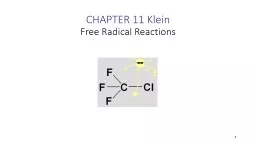

Free Radical Reactions Overview 2 Radical Structure and Stability Free Radical Halogenation of Alkanes Bromination vs Chlorination Selectivites and Hammonds Postulate Allylic Halogenation AutoOxidation at resonancestabilized carbon ID: 557455
Download Presentation The PPT/PDF document "1 CHAPTER 11 Klein" is the property of its rightful owner. Permission is granted to download and print the materials on this web site for personal, non-commercial use only, and to display it on your personal computer provided you do not modify the materials and that you retain all copyright notices contained in the materials. By downloading content from our website, you accept the terms of this agreement.
Slide1
1
CHAPTER 11 KleinFree Radical ReactionsSlide2
Overview
2
Radical Structure and Stability
Free Radical Halogenation of Alkanes
Bromination vs Chlorination: Selectivites and Hammond’s Postulate
Allylic Halogenation
Auto-Oxidation at resonance-stabilized carbon
Free Radical Inhibitors
Free Radical Addition of HBr to Alkenes (Review)Slide3
Homolytic vs Heterolytic Cleavage
3Slide4
4
Radicals:
Molecular species containing unpaired electrons
Homolytic Cleavage:
Non-polar weak bonds
Nonpolar solvents
Gas phase
Heterolytic Cleavage:
Structure of bonded
atoms support ion formation
Polar solvents (stabilize ions)Slide5
5
A carbon radical is
sp
2
hybridized and trigonal planar
Carbon Radicals: Structure and ReactivitySlide6
Hyperconjugation
6Slide7
7
Free Radical Halogenation (FRH)Slide8
FRH Mechanism: Termination
8Slide9
Enthalpy Changes in Chlorination
CH3-H + Cl-Cl
CH
3
-Cl + H-Cl
Bonds Broken
D
H
°
(
per Mole
)
Bonds Formed
D
H
°
(
per Mole
)
Cl-
+242 kJ
H-Cl
-431 kJ
CH
3
H
2
-H
+410 kJ
CH
3
CH2-Cl-351 kJTOTAL+652 kJTOTAL-782 kJ
Step One: DH° = +410 kJ + (-431 kJ) = -21 kJ/molStep Two: DH° = +242 kJ + (-351) kJ) = -109 kJ/molNet: DH° = +652 kJ + (-782 kJ) = -130 kJ/mol
9Slide10
Energetics of Propagation
10Slide11
Energy Diagram for Propagation Steps: Cl•Both steps are exothermic in chlorination
11Slide12
In the Free Radical Halogenation (FRH) of Alkanes, more than one product may form. Bromination is selective, whereas Chlorination is not
12Slide13
Difference is due to Energy Differences at the Rate Limiting Propagation Step (#1)
13Slide14
An Exothermic reaction step creates a transition state that has undergone less structural reorganization than an endothermic step
14Slide15
Hammond’s PostulateStates connected on an reaction pathway that are similar in Energy must also then be similar in StructureThe structure of the transition state resembles the structure of the closest stable species.Endothermic reaction: Transition state resembles the product.Exothermic reaction: Transition state resembles the reactant.
15Slide16
Endothermic and Exothermic Diagrams
Chapter 4
16Slide17
Energy Diagrams: Chlorination Versus Bromination
17Slide18
More Stable Products form faster if Ea depends on final structure
18Slide19
19
Product Distribution depends on
Two factors
:
The statistical likelihood of the product forming (#H’s at that site in the reactant)
The relative reactivity of each C-H with the Cl•
Here the
statistical product ratio
is 6:2 (3:1)
At 25
o
C the
observed
product ratio is 43:57 rather than 3:1.
The relative reactivity (RR) of the 2° C-H must therefore be 4 times greater than for the 1° C-H
OBS = STATxRRSlide20
Chlorination generally creates mixtures of products, whereas bromination produces just one
20